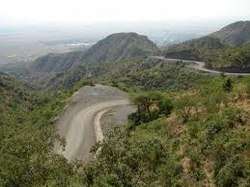Alamata
Alamata (Tigrinya: ኣላማጣ) is a town and separate woreda ('Alamata Town') in Tigray, Ethiopia. Located in the Debubawi (Southern) zone of the Tigray region (or kilil), it has a latitude and longitude of 12°25′N 39°33′E and an elevation of 1,520 metres (4,990 ft) above sea level and is located along Ethiopian Highway 2. It is surrounded by Alamata woreda.
Alamata ኣላማጣ | |
|---|---|
 Flag | |
 Alamata Location within Ethiopia | |
| Coordinates: 12°25′N 39°33′E | |
| Country | Ethiopia |
| Region | Tigray |
| Zone | Debubawi (Southern) |
| Elevation | 1,520 m (4,990 ft) |
| Population (2007) | |
| • Total | 33,214 |
| Time zone | UTC+3 (EAT) |
History
19th Century
On 14 December 1895, Emperor Menilek's passed through Alamata on their way northwards against the Italians. Arbegnoch under British leadership, liberated the town from Italian control during the Second World War on 5 May 1941; it was at the southern edge of the Woyane rebellion of 1943.[1] On 14 December 1895, Emperor Menilek's passed through Alamata on their way northwards against the Italians.
20th Century
Arbegnoch under British leadership, liberated the town from Italian control during the Second World War on 5 May 1941; it was at the southern edge of the Woyane rebellion of 1943.
The first reports of crop failure in Wollo, were made in October 1971 by the chief municipal officer of Alamata; this report was handled very indifferently by his superiors who did not respond until July 1972, when they asked for a revised report.
Alamata was garrisoned by the Derg during the Ethiopian Civil War. The Tigray People's Liberation Front captured the town in 1988.
Demographics
Based on the 2007 national census, Alamata has a total population of 33,214, of whom 16,140 are men and 17,074 women. 82.35% of the population said they were Orthodox Christians, and 16.96% were Muslim.[2]
The 1994 census reported this town had a total population of 26,179 of whom 12,094 were males and 14,085 were females.
Geography
Location
Alamata woreda is located in the southern zone of Tigray, bordered by Raya Azebo in the North, Ofla in the west, Amhara in the south and Afar in the east. It is situated 600 kilometres (370 mi) north of Addis Ababa and about 180 kilometres (110 mi) south of the Tigray Regional capital city, Mekelle.
The woreda has ten tabias (wards): Tumuga, Selen Wuha, Limaat, Selam Bekalsi, Kulu Gize Lemlem, Gerjale, Ta`o, La`elay Dayu, Tsetsera and Merewa.
Topography
Topographically, Alamata is divided into western highland and eastern lowland. The western part (Tsetsera and Merewa) is categorized under the northern highlands of Ethiopia, having an altitude range of 2,000–3,000 metres (6,600–9,800 ft). It is characterized by steep slopes, gorges and undulating terrain having scattered flat lands used for grazing livestock and farming. It covers 25% of the woreda. The topography of the area dominated by steep slopes has induced erosion. The eastern lowland with its eight tabias is generally plain in topography with an altitude ranging from 1,450–1,750 metres (4,760–5,740 ft). The plain landscape of this area makes the area suitable for agriculture and it covers 75% of the woreda.[3]
Alamata is located in the endoreic basin of the Afar Triangle. The streams near Alamata do not reach the ocean.

Economy
Agriculture
A mixed farming system with the predominate of crop production is practiced in the district. The major food crops grown in the area are cereals (sorghum, teff, and maize), pulses, oilseeds, vegetables and root crops.[4]
Electricity
A 458 kilometres (285 mi) high voltage transmission line was constructed to transport electricity from Alamata to Legetafo in central Ethiopia.[5]
Transportation
The Weldiya–Mekelle Railway will have a station in Alamata.[6]
Notes
- "Local History in Ethiopia" Archived 2007-09-27 at the Wayback Machine (pdf) The Nordic Africa Institute website (accessed 6 September 2007)
- Census 2007 Tables: Tigray Region Archived 2010-11-14 at the Wayback Machine, Tables 2.1, 3.1, 3.2, 3.4.
- Mebrahtu, Tirhas (2009). Understanding Local Forest Management Institutions and their Role in Conserving Woody Species Biodiversity. Mekelle: Mekelle University.
- TARI, 2004
- Liangyu, ed. (6 July 2018). "Ethiopia inaugurates Chinese-built electricity transmission line". Xinhua. Retrieved 29 October 2018.
- China Communications Construction Company (2015). Weldiya/Hara Gebeya – Mekele Railway Project Basic Design / Route. Beijing: China Communications Construction Company.